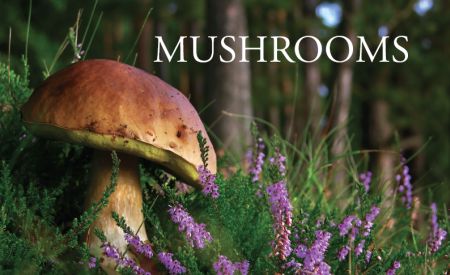
A walk through the woods will likely reveal several varieties of mushrooms, and chances are that some are the types that are edible. However, because some mushrooms are very poisonous, it is important never to try a mushroom of which you are unsure. Never eat a mushroom with gills, or, for that matter, any mushroom that you cannot positively identify as edible. Also, never eat mushrooms that appear wilted, damaged, or rotten.
Here are some common edible mushroom that you can easily identify and enjoy.
Chanterelles
These trumpet-shaped mushrooms have wavy edges and interconnected blunt-ridged gills under the caps. They are varied shades of yellow and have a fruity fragrance. They grow in summer and fall on the ground of hardwood forests. Because chanterelles tend to be tough, they are best when slowly sautéed or added to stews or soups.
Notes: Beware of Jack O’Lantern mushrooms, which look and smell similarly to chanterelles. Jack O’Lanterns have sharp knifelike gills instead of the blunt gills of chanterelles, and generally grow in large clusters at the base of trees or on decaying wood.
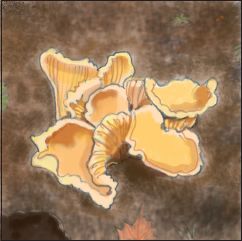
Chanterelles

Morel mushroom
Coral Fungi
These fungi are aptly named for their bunches of upward-facing branching stems, which look strikingly like coral. They are whitish, tan, yellowish, or sometimes pinkish or purple. They may reach 8 inches in height. They grow in the summer and fall in shady, wooded areas.
Notes: Avoid coral fungi that are bitter, have soft, gelatinous bases, or turn brown when you poke or squeeze them. These may have a laxative effect, though are not life-threatening.
Coral fungi
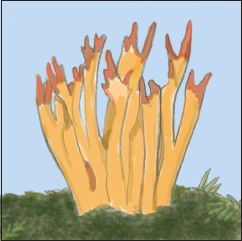
Morels
Morels are sometimes called sponge, pine cone, or honeycomb mushrooms because of the pattern of pits and ridges that appears on the caps. They can be anywhere from 2 to 12 inches tall. They may be yellow, brown, or black and grow in spring and early summer in wooded areas and on river bottoms. To cook, cut in half to check for insects, wash, and sauté, bake, or stew.
Notes: False morels can be poisonous and appear similar to morels because of their brainlike irregularly shaped caps. However, they can be distinguished from true morels because false morel caps bulge inward instead of outward. The caps have lobes, folds, flaps, or wrinkles, but not pits and ridges like a true morel.
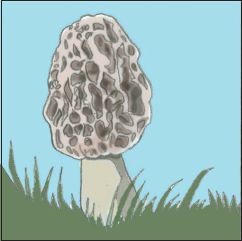
Morel
Puffballs
These round or pear-shaped mushrooms are often mistaken for golf balls or eggs. They are always whitish, tan, or gray and sometimes have a thick stem. Young puffballs tend to be white and older ones yellow or brown. Fully matured puffballs have dark spores scattered over the caps. Puffballs are generally found in late summer and fall on lawns, in the woods, or on old tree stumps. To eat, peel off the outer skin and eat raw or batter-fried.
Notes: slice each puffball open before eating to be sure it is completely white inside. If there is any yellow, brown, or black, or if there is a developing mushroom inside with a stalk, gills, and cap, do not eat! Amanitas, which are very poisonous, can appear similar to puffballs when they are young. Do not eat if the mushroom gives off an unpleasant odor.
Puffball
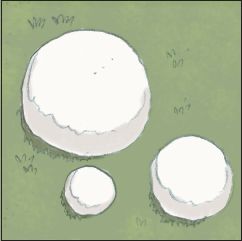
Shaggy Mane Mushrooms
This mushroom got its name from its cap, which is a white cylinder with shaggy, upturned, brownish scales. As the mushroom matures, the bottom outside circumference of the cap becomes black. Shaggy manes are generally 4 to 6 inches tall and grow in all the warm seasons in fields and on lawns.
Shaggy manes are tastiest eaten when young, but they’re easiest to identify once the bottoms of the caps begin to turn black. They are delicious sautéed in butter or olive oil and lightly seasoned with salt, garlic, or nutmeg.
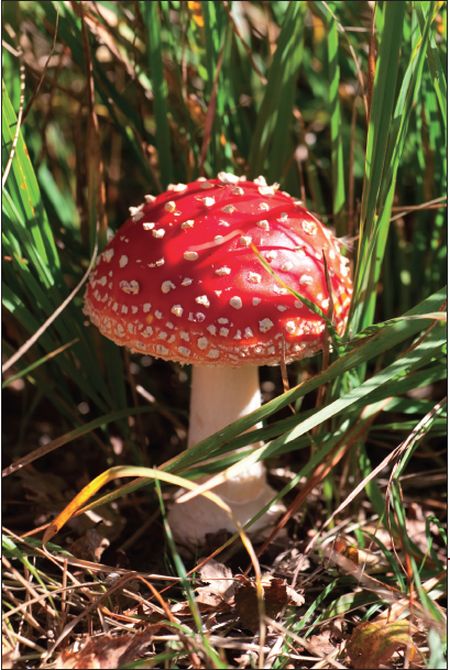
Amanita mushrooms are very poisonous. Do not eat any mushroom that resembles an amanita.
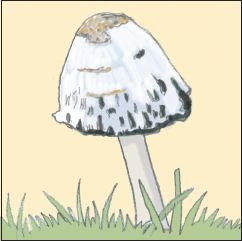
Shaggy Mane Mushroom